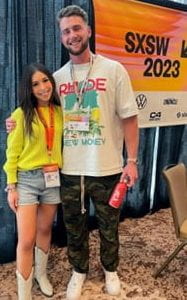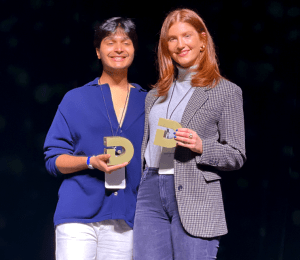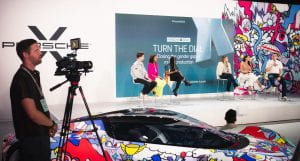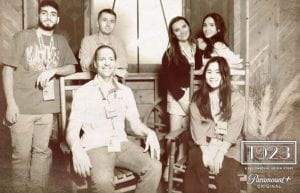Written by SMU Graduate Advertising Students:
Gabriela Vascimini and Shelby Steur
 The Porsche Activation was an incredible combination of innovation and entertainment. The perception of the Porsche brand is sleek yet transformative, this reinforces the well thought out partnership with Transformers for this event.
The Porsche Activation was an incredible combination of innovation and entertainment. The perception of the Porsche brand is sleek yet transformative, this reinforces the well thought out partnership with Transformers for this event.
Sprout Social x TikTok
The session Ephemeral trend culture is transforming business allowed me to think about more unique ways to implement tiktok into every industry. Allowing relevance and social communication to take a front seat approach. Jamie Gilpin CMO of sprout social said “The only constant is absolute change”, this comment brought to mind how little we know about the direction social media will take and to use this to our advantage when completing a campaign.
Agency and Creators Mixer
The Agency and Creators mixer gave professionals a chance to meet each other and connect with others in the same industries. I was able to meet several people in both the nonprofit and purpose driven marketing categories. This gave me the opportunity to discuss what to look for throughout a job search and tips for success. It was amazing to talk to someone who was doing the work I look forward to in the future.
This gave me the opportunity to discuss what to look for throughout a job search and tips for success. It was amazing to talk to someone who was doing the work I look forward to in the future.
Keynote: Priyanka Chopra Jonas in Conversation with Jennifer Salke
 This inspiring conversation between acclaimed actress, activist, and philanthropist Priyanka Chopra Jonas and Head of Amazon + MGM Studios (and former head of NBC studios) Jennifer Salke was surprisingly enlightening and relevant to the world of advertising and branding. While positioned as a film event, both women offered great insight as to the importance of storytelling when trying to communicate any message––including an advertising message. Those in attendance were first treated to a sneak peek to their latest project, a spy thriller series starring Chopra entitled Citadel. Citadel, premiering April 28th, is a new kind of show––a global program. Other than the “mothership” series, two additional foreign series will also be released, one taking place in Italy and one in India, existing with the same universe as Citadel. This has never been attempted before, and is truly a groundbreaking moment for TV shows worldwide.
This inspiring conversation between acclaimed actress, activist, and philanthropist Priyanka Chopra Jonas and Head of Amazon + MGM Studios (and former head of NBC studios) Jennifer Salke was surprisingly enlightening and relevant to the world of advertising and branding. While positioned as a film event, both women offered great insight as to the importance of storytelling when trying to communicate any message––including an advertising message. Those in attendance were first treated to a sneak peek to their latest project, a spy thriller series starring Chopra entitled Citadel. Citadel, premiering April 28th, is a new kind of show––a global program. Other than the “mothership” series, two additional foreign series will also be released, one taking place in Italy and one in India, existing with the same universe as Citadel. This has never been attempted before, and is truly a groundbreaking moment for TV shows worldwide.
Salke emphasized the importance of globalization in today’s entertainment world, a sentiment deeply echoed by Chopra, who began her career starring in Bollywood and Hindi language films prior to becoming an actress in Hollywood. She noted how, during the pandemic, many people began to watch foreign shows with subtitles and the practice has become far more mainstream. Chopra then shared a sweet anecdote about her mother’s love for Korean dramas, and mentioned how that was when she realized television and acting could truly transport audiences to anywhere in the world. The most notable point that Chopra and Salke left the audience with was a call for greater diversity in television––not just in regard to how actors look, but how they sound and the languages they share their stories in.
Content Creator Meet-Up & Panel
 This exciting event began with a conversation and information question and answer session featuring Netflix star and social media sensation Harry Jowsey and his manager Jeff Duncan, CEO of Ingenuity Live, and talent and influencer management company. Both offered insights into the content creation world from the wildly varied perspectives of talent and business manager, making for an incredibly well-rounded presentation. Following their discussion, they opened up the floor to questions and then encouraged all of the content creators in attendance to mix and mingle with each other, launching the conversation with some icebreaker questions. As a content creator both for a fashion brand as well as for my own personal brand, I found it interesting to meet content creators on both the business side and on the lifestyle/personal brand side. After the event, I caught up with Harry and we talked a bit more about what it is really like being a content creator, from dealing with negative comments to landing your dream brand deals. He emphasized the importance of creating content that brings out your personality, and this is true whether you are creating content to bolster your personal brand or as marketing content for an established company. One thing is clear––short form video content is the new frontier in advertising, and isn’t going anywhere anytime soon.
This exciting event began with a conversation and information question and answer session featuring Netflix star and social media sensation Harry Jowsey and his manager Jeff Duncan, CEO of Ingenuity Live, and talent and influencer management company. Both offered insights into the content creation world from the wildly varied perspectives of talent and business manager, making for an incredibly well-rounded presentation. Following their discussion, they opened up the floor to questions and then encouraged all of the content creators in attendance to mix and mingle with each other, launching the conversation with some icebreaker questions. As a content creator both for a fashion brand as well as for my own personal brand, I found it interesting to meet content creators on both the business side and on the lifestyle/personal brand side. After the event, I caught up with Harry and we talked a bit more about what it is really like being a content creator, from dealing with negative comments to landing your dream brand deals. He emphasized the importance of creating content that brings out your personality, and this is true whether you are creating content to bolster your personal brand or as marketing content for an established company. One thing is clear––short form video content is the new frontier in advertising, and isn’t going anywhere anytime soon.
VW & Lucasfilm Join Forces with special guest Doug Chiang, Executive Creative Director at Lucasfilm
While it’s clear that the Disney and VW execs didn’t have to force anything when it came to joining together their two iconic brands, countless hours of strategy, research, and an impeccable attention to detail were all necessary to pull off this epic partnership––something that audiences got a special behind-the-scenes look at during this panel. The panel, featuring Ty Ervin (Vice President of Marketing Partnerships at Disney), Gilbert Heise (Chief Strategist of Volkswagen Brand), Kevin Lane Keller (E.B. Osborn Professor of Marketing and Senior Associate Dean for Marketing & Communications at Dartmouth College), and none other than Doug Chiang, Executive Creative Director for Lucasfilm, was moderated by Co-Editor in Chief of Variety Magazine, Cynthia Littleton. The panelists discussed how storytelling intersects with marketing messages, and how brands can connect with audiences authentically by using both nostalgia and excitement for tomorrow to make marketing messages resonate with them more deeply. They also stressed the importance of maintaining audience trust, especially with dealing with beloved IP such as Star Wars, and how to keep character integrity while balancing it with creative freedom and new ideas. Chiang quipped that successful brands all share three inherent qualities: Artfulness, character, and humanity.

Those in attendance even got to see a special preview of a still-under-production forthcoming TV spot that will continue this epic collaboration: it features none other than Star Wars icon Grogu, those infamously curious Jawas, and more familiar faces to promote the latest season of Disney+ hit The Mandalorian. Still, Star Wars is only the beginning for the partnership between Disney and Volkswagn––Heise seemed to be constantly hinting at upcoming projects involving the two powerhouse brands featuring different Disney-owned franchises, while Ervin seemed sworn to secrecy. We can only wait to find out as to what’s next.
After the event, I was able to chat with Chiang for a few minutes and thank him for the insights he’d shared with us. We talked about the intersection between branding and storytelling, and he emphasized how he truly believes that storytelling is the backbone of a solid brand. He mentioned that George Lucas always stresses this as well during the creative process, saying that every component––whether in regard to a film, a book, or a TV spot––must have a story to tell. Even products, in order to become iconic, must have personality. And, when it comes down to it, that’s exactly what VW and Disney joined forces to do. They showed audiences that their vehicle was more than just a mode of transportation, but a living, breathing character full of personality––just like R2D2 and C3PO as they ooh and awe at the in the TV spot.




















